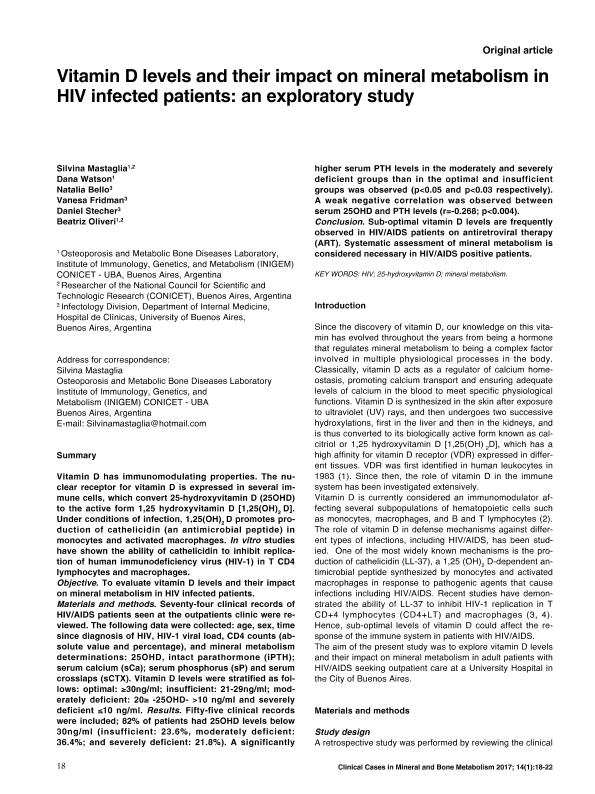Artículo
Vitamin D levels and their impact on mineral metabolism in HIV infected patients: An exploratory study
Mastaglia, Silvina Rosana ; Watson, Dana Zoe; Bellotti, Natalia
; Watson, Dana Zoe; Bellotti, Natalia ; Fridman, Vanesa; Stecher, Daniel; Oliveri, María Beatriz
; Fridman, Vanesa; Stecher, Daniel; Oliveri, María Beatriz
 ; Watson, Dana Zoe; Bellotti, Natalia
; Watson, Dana Zoe; Bellotti, Natalia ; Fridman, Vanesa; Stecher, Daniel; Oliveri, María Beatriz
; Fridman, Vanesa; Stecher, Daniel; Oliveri, María Beatriz
Fecha de publicación:
03/2017
Editorial:
CIC Edizioni Internazionali
Revista:
Clinical Cases in Mineral and Bone Metabolism
ISSN:
1971-3266
Idioma:
Inglés
Tipo de recurso:
Artículo publicado
Clasificación temática:
Resumen
Vitamin D has immunomodulating properties. The nuclear receptor for vitamin D is expressed in several immune cells, which convert 25-hydroxyvitamin D(25OHD) to the active form 1,25 hydroxyvitamin D (1,25(OH)2 D). Under conditions of infection, 1,25(OH)2 D promotes production of cathelicidin (an antimicrobial peptide) in monocytes and activated macrophages. In vitro studies have shown the ability of cathelicidin to inhibit replication of human immunodeficiency virus (HIV-1) in T CD4 lymphocytes and macrophages. Objective: To evaluate vitamin D levels and their impact on mineral metabolism in HIV infected patients. Materials and Methods: Seventy-four clinical records of HIV/AIDS patients seen at the outpatients clinic were reviewed. The following data were collected: age, sex, time since diagnosis of HIV, HIV-1 viral load, CD4 counts (absolute value and percentage), and mineral metabolism determinations: 25OHD, intact parathormone (iPTH); serum calcium (sCa); serum phosphorus (sP) and serum crosslaps (sCTX). Vitamin D levels were stratified as follows: optimal: ≥30ng/ml; insufficient: 21-29ng/ml; moderately deficient: 20 -25OHD- >10 ng/ml and severely deficient ≤10 ng/ml. Results: Fifty-five clinical records were included; 82% of patients had 25OHD levels below 30ng/ml (insufficient: 23.6%, moderately deficient: 36.4%; and severely deficient: 21.8%). A significantly higher serum PTH levels in the moderately and severely deficient groups than in the optimal and insufficient groups was observed (p<0.05 and p<0.03 respectively). A weak negative correlation was observed between serum 25OHD and PTH levels (r=-0.268; p<0.004). Conclusion: Sub-optimal vitamin D levels are frequently observed in HIV/AIDS patients on antiretroviral therapy (ART). Systematic assessment of mineral metabolism is considered necessary in HIV/AIDS positive patients.
Palabras clave:
25-Hydroxyvitamin D
,
Hiv
,
Mineral Metabolism
Archivos asociados
Licencia
Identificadores
Colecciones
Articulos(INIGEM)
Articulos de INSTITUTO DE INMUNOLOGIA, GENETICA Y METABOLISMO
Articulos de INSTITUTO DE INMUNOLOGIA, GENETICA Y METABOLISMO
Citación
Mastaglia, Silvina Rosana; Watson, Dana Zoe; Bellotti, Natalia; Fridman, Vanesa; Stecher, Daniel; et al.; Vitamin D levels and their impact on mineral metabolism in HIV infected patients: An exploratory study; CIC Edizioni Internazionali; Clinical Cases in Mineral and Bone Metabolism; 14; 1; 3-2017; 18-22
Compartir
Altmétricas



